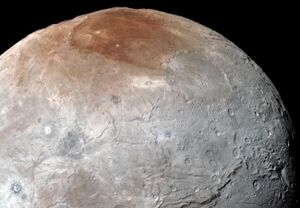Astronomy:Dorothy (crater)
Dorothy Crater is the official name used to describe two features in the solar system; an impact crater on Venus, and a large impact basin on Pluto's moon, Charon.
Charon
 Dorothy is the largest crater on Charon, appearing in the upper-right of this image. | |
| moon | Charon |
|---|---|
| Coordinates | [ ⚑ ] 58°30′N 40°36′E / 58.5°N 40.6°E[1] |
| Diameter | 261 km |
| Depth | 6 km |
| Discoverer | New Horizons |
Dorothy Crater is the largest known impact basin on Pluto's moon Charon. The crater was discovered by the New Horizons space probe in 2015 during its flyby of Pluto and its moons. It was named after Dorothy Gale from the novel The Wonderful Wizard of Oz.[1] The crater is located near Charon's north pole, and overlaps the edge of Mordor Macula.
Venus
| Coordinates | [ ⚑ ] 35°24′S 11°18′E / 35.4°S 11.3°E[2] |
|---|---|
| Diameter | 8.4 km |
The names for small craters on Venus (with a diameter less than 20 km) are chosen from common female names.[3] Dorothy is a Greek first name, and the crater was officially designated by the IAU in 1997. The crater is east of Tamfana Corona, and south of Seoritsu Farra.[4]
Like many impact craters on Venus, Dorothy has been flooded and buried by lava flows.[5]
See Also
- List of geological features on Charon
- List of craters on Venus
References
- ↑ 1.0 1.1 "Dorothy (crater)". Gazetteer of Planetary Nomenclature. USGS Astrogeology Research Program.
- ↑ "Dorothy (crater)". Gazetteer of Planetary Nomenclature. USGS Astrogeology Research Program.
- ↑ "Dorothy" (in en). http://wenamethestars.inkleby.com/feature/1584. Retrieved 10 April 2020.
- ↑ International Astronomical Union (June 8, 2012). Venus V-44 Kaiwan Fluctus Nomenclature (Map). USGS Astrogeology Science Center. Retrieved April 10, 2020.
- ↑ Collins, G. C.; Head, J. W.; Basilevsky, A. T.; Ivanov, M. A. (1999-10-25). "Evidence for rapid regional plains emplacement on Venus from the population of volcanically embayed impact craters" (in en). Journal of Geophysical Research: Planets 104 (E10): 24121–24139. doi:10.1029/1999JE001041. http://doi.wiley.com/10.1029/1999JE001041.



